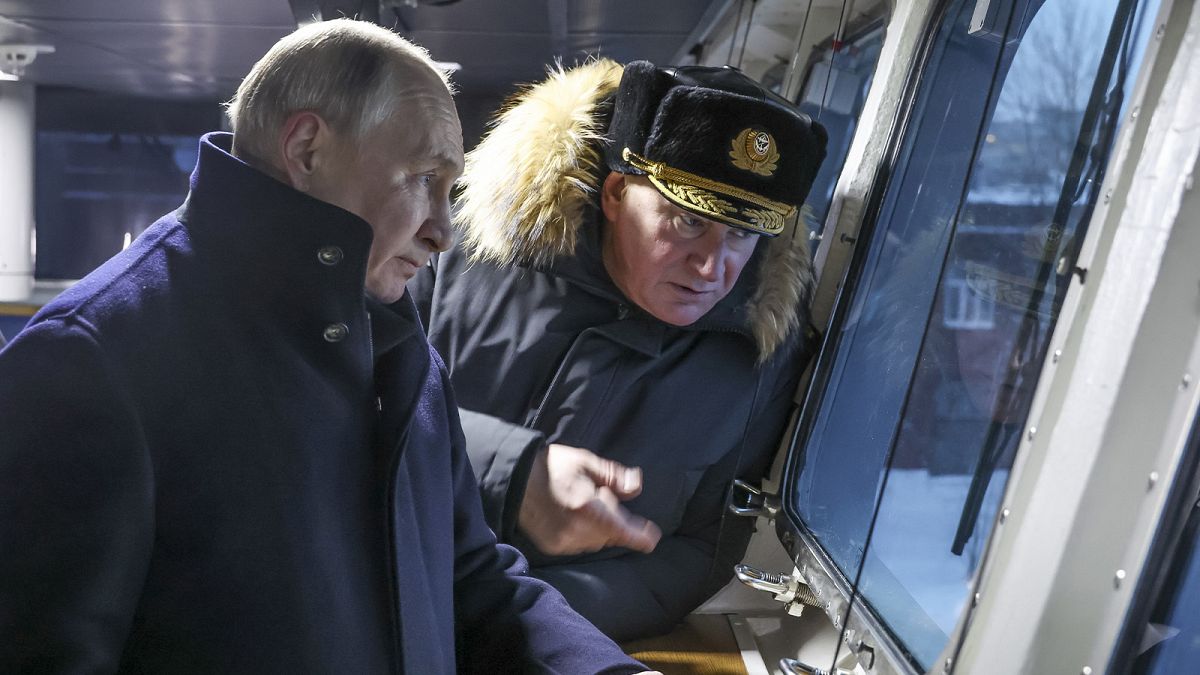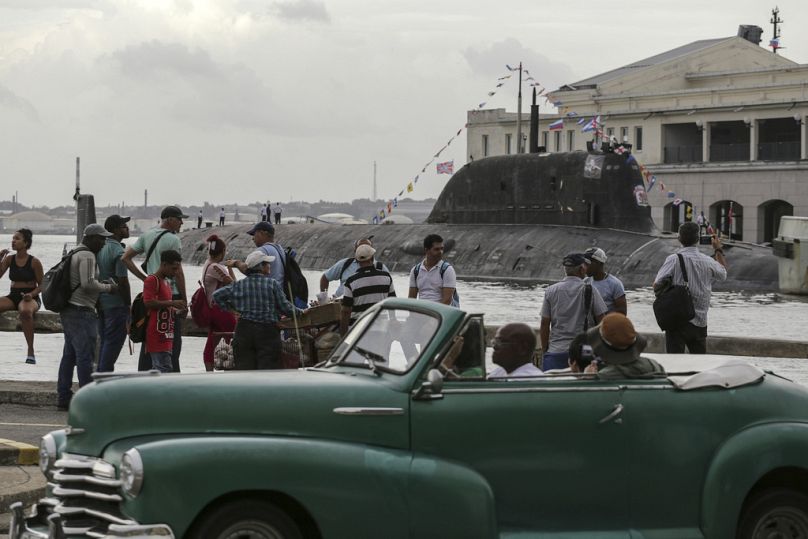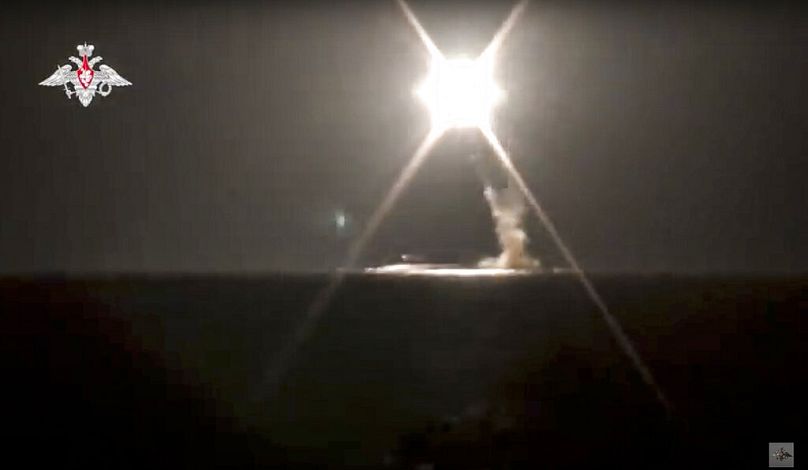The US Navy keeps closely monitoring a Russian Yasen-M class submarine that just left Cuba. The top-of-the-line nuclear sub's presence in the Americas could mark a new step in Russian navy operations and strategy.
Destination: Unknown. The Russian nuclear-powered submarine K-561 Kazan is still navigating the Caribbean Sea after it left the Havana harbour moorings.
The Yasen-class cruise missile sub is part of a naval group composed of an Admiral Gorshkov-class frigate — carrying the hypersonic anti-ship missile Tsirkon — a tug, and an auxiliary tanker vessel.
According to Western military sources, the ships under the Russian Navy's St Andrew banner could be on their way to Venezuela, another Moscow-leaning country in the Americas.
Since starting its travels in the Atlantic Ocean, Western navies have closely monitored the Russian naval group.
The presence of Russian units in international waters off the Florida coast has raised the alert for the US and its allies, like Canada.
The naval group poses strategic concerns for the US and Canadian militaries about the projection and capacity of the Russian military fleet.
The trip does not pose an immediate threat, according to authorities on both sides, as well as in the ships' host country, Cuba. Both the Kazan submarine and the Gorshkov frigate carry missiles "without nuclear warheads," as Havana openly declared last week.
Different elements, plenty of unknowns
Havana has been on friendly terms with Moscow since the time of the communist Soviet Union, and the visit is not the first time that Russian war vessels have docked in Cuba.
Yet, the Pentagon downplayed the alerts and the comparisons with the Cuban missile crisis of 1962.
"These are routine naval visits that we've seen under different administrations," a Pentagon spokesperson said.
Nevertheless, the US National Security Council seems to think slightly differently from the Defence Department's point of view. In the eyes of the NSC, the presence of nuclear-powered submarines near US waters must be considered in a wider context concerning the Russian maritime strategy.
US National Security Advisor Jake Sullivan pointed out that ”this time, there’s a different element in the deployment of Russian warships to Cuba. For the first time, they included a nuclear submarine, the Yasen-class Kazan".
For the West, there are still a number of unknowns regarding the fleet's trip to the south, and the fact that US security agencies seem more concerned about the submarine than the frigate despite the warship's heavy armaments raises further questions.
And then there is Moscow's war in Ukraine. Military analysts say that the Russian Navy's performance in the Black Sea has been inadequate after its major naval losses, and this trip might be a way to show off the Kremlin's military might.
In addition, Russian nuclear-powered submarines — especially the last-generation ones like the Kazan — are still an enigma for most Western analysts, with some thinking that Russian underwater warfare could be the trump card of an apparently depleted navy.
What do we know about the Yasen-M class submarine?
According to the US outlet National Interest, the Yasen class vessels rank among the top five attack submarines in the world, together with Russia's Sierra II-class (aka Kondor), the UK's Astute-class, and the US Virginia-class and Seawolf-class subs.
Like the Kazan, the Yasen-M submarines are the most recent upgrade on the original Yasen, first introduced in 2009.
The Yasen class has been developed from a project dating back to the last days of the Soviet Union. Nevertheless, NATO analysts regard it as a formidable underwater vessel used for deterrence and defence.
A report from the Royal United Services Institute (RUSI) from 2021 underlines that the characteristics of the Kazan-like submarines represent an evolution to the "nuclear guided-missile submarines (SSGNs), which is likely indicative of a shift in the way that Russian submarines will contribute to future campaigns."
"Long-range strike missions appear to be superseding sea lines of communication (SLOC) interdiction as a primary task," RUSI said at the time.
This means that the retrofitted Kazan-M subs went from their original purpose — hunter-killer missions against ships and convoys — to being able to hit inland targets from the ocean with hypersonic cruise missiles.
Kazan is quite a difficult catch for any potential hunter-killer equivalent and a real threat in case of conflict, Dr Sidharth Kaushal from RUSI said.*
"Yasen is a concern for two reasons. First, its vulnerability to passive detection is considerably lower than that of older Russian boats, making it comparable to Western submarines. In previous years, the submarine has eluded detection for extended periods," Dr Kaushal explained.
"It is also equipped with vertical launch cells for cruise missiles, meaning that if it eludes tracking, it could pose a long-range strike threat to critical military infrastructure with missiles such as the 3M-14 Kalibr and the 3M22 Tsirkon. These capabilities also enable them to outrange some of the surface vessels which may be tasked with tracking them".
Is NATO capable of anti-submarine warfare?
With its trip to the warm Caribbean waters of the Northern fleet, the jewel of the Russian navy has offered Moscow a shot at a diplomatic performance show for the so-called Global South and an opportunity for the US to monitor and study the Yasen-M class.
"NATO has a credible anti-submarine warfare system, and Russia has a more limited force than it did in the Cold War. Russian attack submarines are also needed for tasks such as the defence of Russia’s submarine ballistic missile fleet, which limits the number of submarines that can be used for offensive functions," said Dr Kaushal.
Nevertheless, antisubmarine warfare has huge costs in terms of resources in case of military escalation.
"This will likely necessitate a change in how NATO manages the anti-submarine warfare challenge in the High North, given that a strategy of barrier defence at the Greenland–Iceland–UK (GIUP) gap may do little to impact Russian submarines, which may have little need to traverse this barrier in order to achieve their operational ends," the 2021 RUSI report stated.
The Russian fleet suffered heavy setbacks in the Black Sea in the last two years of the Ukrainian war. Notably, Ukraine hit and sunk two Russian diesel-powered submarines in the bay of Sevastopol last September.
Many war analysts believe this is evidence that Russian maritime power has been overestimated. Nevertheless, Dr Kaushal argued that the actual threat of a submarine fleet can only be tested when it is in action.
"The Storm Shadow (anti-ship missile) attack in Sevastopol was an embarrassment for the Russian navy, the fact that it happened in port means that this did not prove much about Russian submarine capabilities one way or another," he concluded.
















